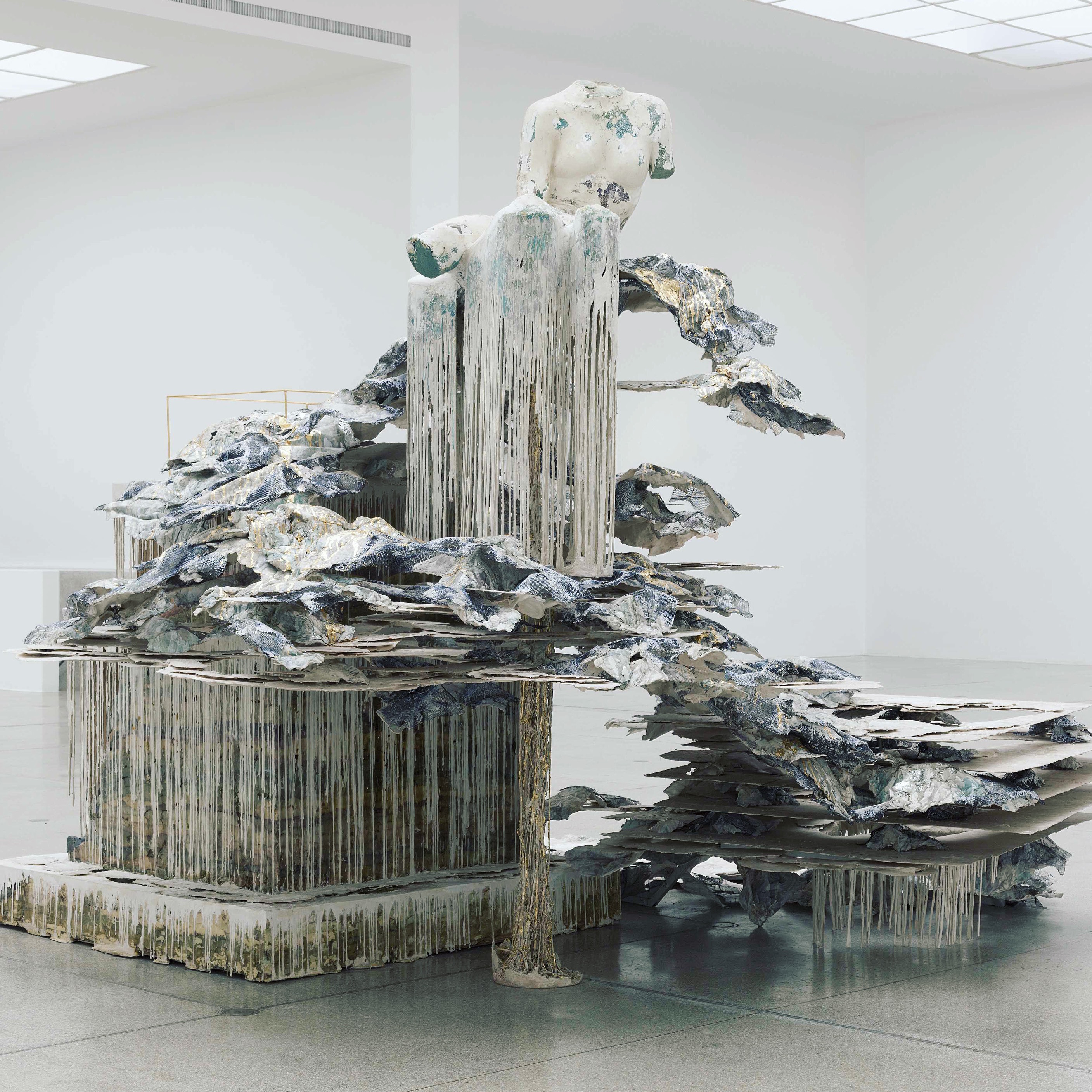Informed by the past, yet jarringly present: Diana Al-Hadid’s first solo show in the Middle East
Known for her tower-like sculptures and drippy gypsum panels, Diana Al-Hadid has made a name for herself as a Renaissance-inspired sculpture artist. Her work reads like hypertext, linking various cultural histories and geography. Despite having been raised in the American Midwest, she was born in her family’s native Aleppo, one of the oldest continuously inhabited cities in the world. Her work recalls ancient civilisations, as if lamenting their extinction. That is not, however, to assume that Al-Hadid’s work is planted in her Syrian heritage; on the contrary, she rejects the postmodern tradition of operation on, as Nicholas Bourriaud explains, ‘a logic of membership’, whereby artists are classified according to their ethnicity and/or culture. She is as much an American artist as she is a Syrian one.
Educated between her home state of Ohio and the East Coast, Al-Hadid now lives and works in New York City. Judging by the scale and materials she uses, one can imagine her Brooklyn studio being immensely large and busy. Phantom Limb, her first solo exhibition in the Middle East, currently on display at New York University in Abu Dhabi, is small, yet unmistakably poignant. The artist has used polymer gypsum, plaster, and fibreglass, amongst other materials, to make relic-like sculptures and panels. Because each piece is composed of such free-flowing shapes, it is clear that Al-Hadid works instinctively, blurring the line between ornate and austere by bringing ancient ruins and old masterpieces back to life. In a city erupting with modernity, Phantom Limb is overwhelming in its ability to resonate and evoke a sense of nostalgia.
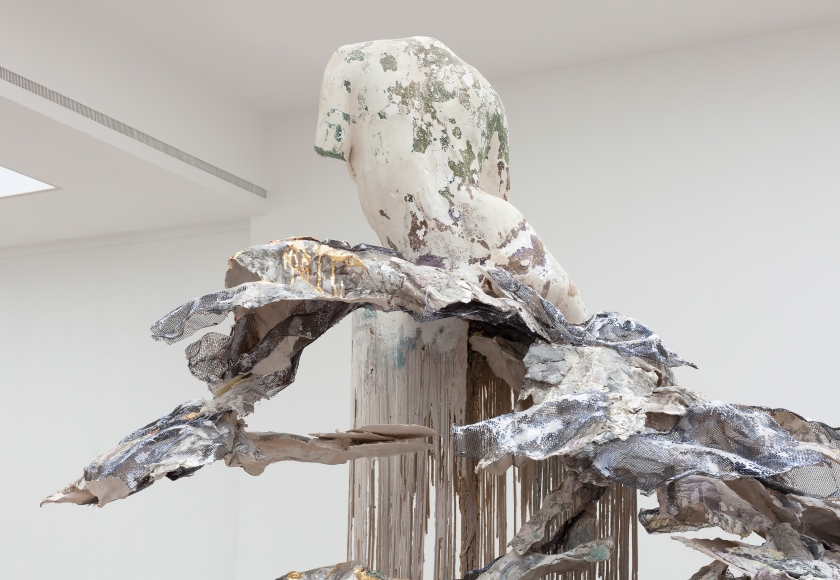
Phantom Limb (detail; courtesy the artist)
Upon entering NYU Abu Dhabi’s modern gallery, viewers face the titular focal point of the exhibition, the 269 x 350 cm sculpture, Phantom Limb. A female bust made of plaster sits at the top of the sprawling structure made of mesh, plaster, and metallic, painted aluminium foil sheets, giving the impression she is being resurrected from the sea. Dried plaster appears to drip from the topmost edge of the sculpture and down the large stacked cubes as if melting, while on the backside, a detached leg sits on a white box: the presumed ‘phantom limb’.
Neighbouring Phantom Limb, Sleepwalker and Still-Life with Gold complete Al-Hadid’s sculptural triptych, Fates. Inspired by a fourth century Greek bas-relief and Hans Memling’s Allegory of Chastity, these two wall insets look like archaeological remnants of the works they were inspired by. The artist alludes to old master paintings several times, in fact; working in threes again, her newest pieces, Attack, Counter-Attack, and Attack Again are intriguing reproductions of Paulo Ucello’s Early Renaissance painting The Battle of San Romano. Painted in her signature polymer gypsum, Al-Hadid works fast, allowing the material to drip and dry, and then painting it with gold leaf and pigment. These panels do not possess the imperishable quality that most other gypsum panels have; rather, they are skeletal and delicate. Understandably so, Al-Hadid describes them as a cross between fresco and tapestry. The cut-out-like negative spaces allow the shadows of the gypsum to appear, adding something of a ghost-like component to the panels, giving them the appearance of shadows, and reminding one of Arabic calligraphy. The panels look different, depending on the angle and proximity they are seen from. For this reason, they are interacted with like sculptures, rather than viewed as two-dimensional shapes.
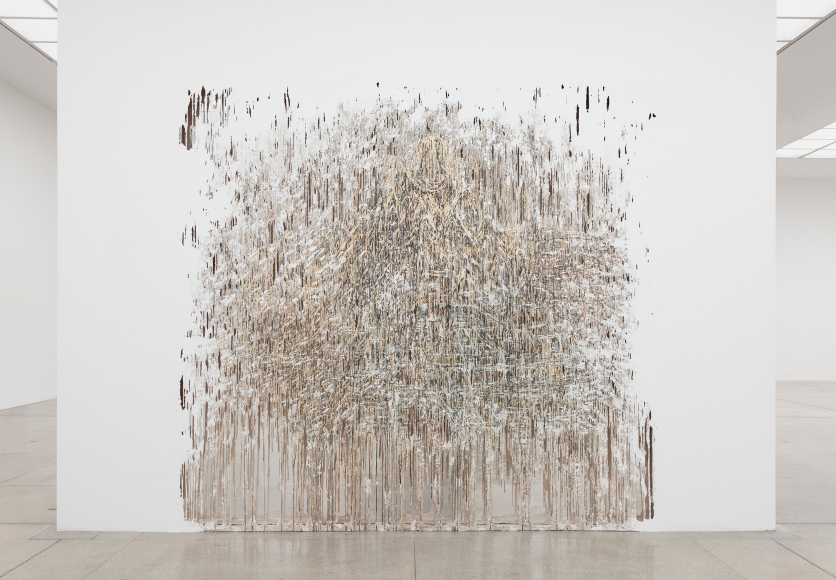
Still-Life with Gold (courtesy the artist)
The female figure subtly reappears in the stirring 466 x 484 cm sculpture, Gradiva’s Fourth Wall; but this time, it is merely insinuated through the drapery of fabric – the same sort used in the architecture of the scene, draping vertically. Resembling ruins, the drapery converges with layers of horizontally floating puddle-like shapes. Gradiva’s Fourth Wall mirrors the organic motion seen in the rest of her work, and is arguably the most hauntingly beautiful piece in the exhibition.
The artist subtly renders a narrative without forcing one, allowing audiences to use their own sense of perception. This is precisely what a phantom limb is: a perceptual experience
Al-Hadid was inspired by Wilhelm Jensen’s 1903 novel, Gradiva, made popular by Sigmund Freud in his psychoanalytical essay Delusion and Dream in Jensen’s ‘Gradiva’. The decision to create the figure in the same fabric as the structure speaks of a fascination with Jensen’s character of Gradiva to blend in with her surroundings. In the gallery guide, the artist describes how the figure ‘becomes kind of part of the architecture and kind of becomes confused with the ruins around her’. Here, she brings into question the relationship between self and place, and body and architecture: if the figure is part of the anatomy of the architecture, being separated from it would be akin to losing a limb. One can then consider if the architecture itself perceives phantom pain.
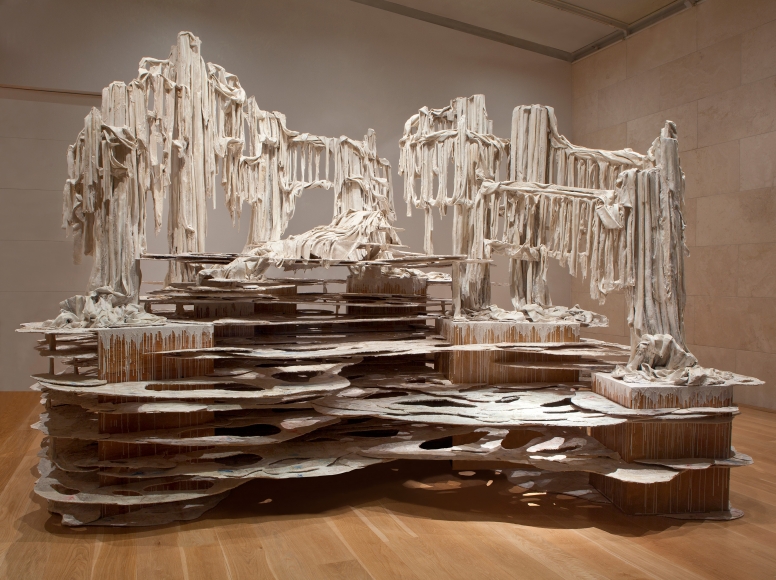
Gradiva’s Fourth Wall (courtesy the artist)
On the other hand, this figure also conceptualises the importance of absence. In Gradiva’s Fourth Wall, the body is as present as it is lacking – one of the great contradictions Al-Hadid makes. By negotiating the human figure without a body, Al-Hadid allows ambiguity to prevent a concrete narrative. Similarly, the wall insets and gypsum panels are abstract in their own right. The artist subtly renders a narrative without forcing one, allowing audiences to use their own sense of perception. This is precisely what a phantom limb is: a perceptual experience.
Through formulating moments, Al-Hadid’s works resist being identified as specific objects or manifestations. In Phantom Limb, the stacked cubes contend with the ascending wave and puddle-like components, inviting viewers to confront both the natural and the industrial. What is certain is that her work always includes organic motion frozen in time, an indeterminacy existing in the struggle between the material and spiritual world. ‘Phantom limb’ refers to a condition in which an amputee still feels a missing limb, and in some cases, feels pain. The loss of something temporal is a theme that is present throughout the whole exhibition.
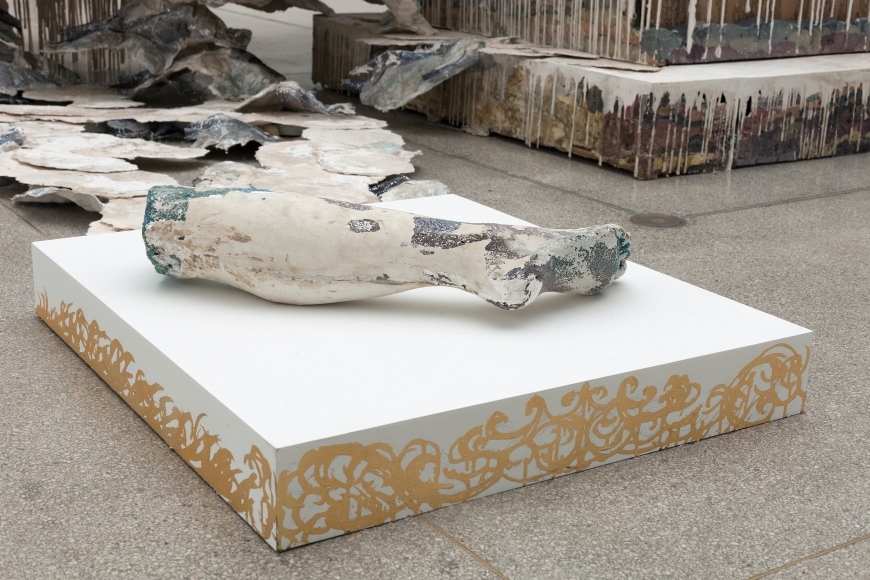
Phantom Limb (detail; courtesy the artist)
Keeping in mind that Al-Hadid has noted how her suburban Midwestern upbringing and immigrant experience have influenced her work, one must be careful not to deduce too many references to Syria in her work. That being said, there are moments of association that invite a more elegiac reading of the exhibition. It is difficult not to think of Aleppo, the modern day ruin-city, when looking at the Pompeii-inspired Gradiva’s Fourth Wall. In an interview with the Hammer Museum, Al-Hadid mentioned Syria’s Hellenistic ruins as being an inspiration. With the country’s ancient ruins being destroyed in current conflicts, Al-Hadid’s work intersects with past triumphs and present cultural anxieties, giving her work the possibility to go beyond the present into the future.
The result of Al-Hadid’s exploration with the past is a well-formulated body of historical fantasy that shifts between melancholy and adoration. Phantom Limb demands a certain reverence that goes beyond casual gallery etiquette. Visitors spend time in silence with each work, as if paying respect to the homages Al-Hadid makes, or possibly to their own gut feelings. Perhaps the most intriguing aspect of the exhibition is each piece’s ability to tell as story through that which is missing, presenting an imaginative ode to what once was but is now no more.
‘Phantom Limb’ runs through May 28, 2016 at NYU Abu Dhabi.
Cover image: Phantom Limb (detail; courtesy the artist).
